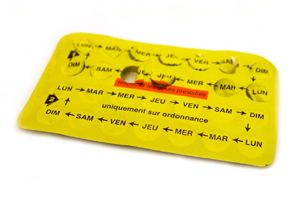Module 3
1. Module 3
1.36. Lesson 9
Module 3—The Male and Female Reproductive Systems
Lesson 9—Medical Use of Reproductive Hormones
 Get Focused
Get Focused

© 2008 Jupiterimages Corporation
Without proper hormonal control of the reproductive system, events like ovulation and sperm production cannot take place. This can result in the lack of fertilization and the failure to ensure continuation of the species. Normal hormone control may be altered knowingly by taking hormones to enhance or prevent pregnancy and to treat disorders. Hormone control may also be altered unknowingly through the effects of endocrine disruptors.
endocrine disruptor: a chemical capable of disrupting hormone function
In reproduction, the term refers to man-made or natural chemicals found in the environment that have unintended negative effects on the reproductive tract, ranging from infertility to cancer.
Endocrine disruptors are synthetic or naturally occurring substances that interfere with the functioning of the body’s normal production of hormones. The endocrine disruptors can be absorbed into the body through contaminated water, food, or air. Their effects can halt or stimulate normal hormone levels, or they may change how hormones travel in the body. The hormone feedback loop can be altered. Some known human endocrine disruptors are dioxin, PCBs, DDT, and diethylstilbesterol (a drug known as DES). Research has found that DES, a synthetic estrogen that was used to prevent miscarriages, often led to increased cervical cancer, birth defects of the uterus and ovaries, and suppression of the immune system in daughters of women who used DES.
Any time the normal release of reproductive hormones is changed, there are consequences. For example, when the release of FSH and LH is affected, the result is a reduced development of egg and sperm. Progestin, synthetic progesterone, was the first chemical used as a female oral contraceptive, known as “the pill.” Varying quantities of estrogen and progesterone are used in today’s contraceptive pills.
Other conditions can be treated with sex hormones. In the initial treatments using chemotherapy, prostate cancer was treated with female sex hormones. Many types of cancer are now treated with female and male sex hormones. Menopause, andropause, impotence, low sperm count, arthritis, and osteoporosis can be treated through the use of sex hormones.
Exposure to endocrine disruptors during development can have permanent effects on an organism. There is further evidence that endocrine disruptors may have consequences for many generations, not just for the immediate person or organism.
Remembering back to “A Fertility Case Study,” both José and Maria had hormone issues associated with their infertility problems. Maria used oral contraceptives for a long time prior to wanting to start a family, and José had misused anabolic steroids for many years.
Understanding how normal reproductive hormones control and affect the body can help you understand how these reproductive hormones are used to promote or reduce conception potential, to treat diseases, and how they are influenced by endocrine disruptors.
Keep the following focusing question in mind as you work through this lesson:
-
What are the various effects of reproductive hormones?

© Dianne Maire/shutterstock
 Module 3: Lesson 9 Assignment
Module 3: Lesson 9 Assignment
Download a copy of the Module 3: Lesson 9 Assignment to your computer now. You will receive further instructions about how to complete this assignment later in the lesson.
In addition to the lesson work you complete for your course folder, you will complete questions on endocrine disruptors in the environment for assessment.
You must decide what to do with the questions that are not marked by the teacher.
Remember that these questions provide you with the practice and feedback that you need to successfully complete this course. You should respond to all of the questions and place those answers in your course folder.
Make any notes about “A Fertility Case Study” from this lesson and place them in your course folder for your teacher’s feedback.
Remember that you also have the option of trying additional questions from the textbook for further practice. Consult with your teacher for the answers to these questions. The Key will also provide you with many Diploma Exam-style multiple-choice, numerical-response, and written-response questions that will be an excellent review of the module. Practising your responses to these types of questions is good preparation for the Diploma Exam.